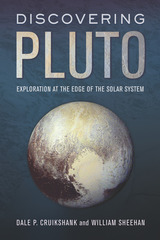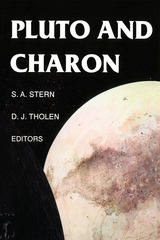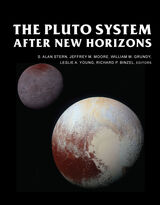3 books about Pluto (Dwarf planet)

Discovering Pluto
Exploration at the Edge of the Solar System
Dale P. Cruikshank and William Sheehan
University of Arizona Press, 2018
Discovering Pluto is an authoritative account of the exploration of Pluto and its moons, from the first inklings of tentative knowledge through the exciting discoveries made during the flyby of the NASA New Horizons research spacecraft in July 2015. Co-author Dale P. Cruikshank was a co-investigator on the New Horizons mission, while co-author William Sheehan is a noted historian of the Solar System.
Telling the tale of Pluto’s discovery, the authors recount the grand story of our unfolding knowledge of the outer Solar System, from William Herschel’s serendipitous discovery of Uranus in 1781, to the mathematical prediction of Neptune’s existence, to Percival Lowell’s studies of the wayward motions of those giant planets leading to his prediction of another world farther out. Lowell’s efforts led to Clyde Tombaugh’s heroic search and discovery of Pluto—then a mere speck in the telescope—at Lowell Observatory in 1930.
Pluto was finally recognized as the premier body in the Kuiper Belt, the so-called third zone of our Solar System. The first zone contains the terrestrial planets (Mercury through Mars) and the asteroid belt; the second, the gas-giant planets Jupiter through Neptune. The third zone, holding Pluto and the rest of the Kuiper Belt, is the largest and most populous region of the solar system.
Now well beyond Pluto, New Horizons will continue to wend its lonely way through the galaxy, but it is still transmitting data, even today. Its ultimate legacy may be to inspire future generations to uncover more secrets of Pluto, the Solar System, and the Universe.
Telling the tale of Pluto’s discovery, the authors recount the grand story of our unfolding knowledge of the outer Solar System, from William Herschel’s serendipitous discovery of Uranus in 1781, to the mathematical prediction of Neptune’s existence, to Percival Lowell’s studies of the wayward motions of those giant planets leading to his prediction of another world farther out. Lowell’s efforts led to Clyde Tombaugh’s heroic search and discovery of Pluto—then a mere speck in the telescope—at Lowell Observatory in 1930.
Pluto was finally recognized as the premier body in the Kuiper Belt, the so-called third zone of our Solar System. The first zone contains the terrestrial planets (Mercury through Mars) and the asteroid belt; the second, the gas-giant planets Jupiter through Neptune. The third zone, holding Pluto and the rest of the Kuiper Belt, is the largest and most populous region of the solar system.
Now well beyond Pluto, New Horizons will continue to wend its lonely way through the galaxy, but it is still transmitting data, even today. Its ultimate legacy may be to inspire future generations to uncover more secrets of Pluto, the Solar System, and the Universe.
[more]

Pluto and Charon
Edited by S. A. Stern and D. J. Tholen
University of Arizona Press, 1997
For five decades after its discovery in 1930, the planet Pluto remained an enigma. However, several events during the last two decades have helped to lift the veil of mystery surrounding the ninth planet. The discovery of its satellite, Charon, in 1978 permitted occultation observations that allowed scientists to determine the size of both bodies. Astronomers also detected the presence of an atmosphere, and the Hubble Space Telescope provided views in unprecedented detail. In addition to these two fortuitous events, advances in telescopic instrumentation and computational methods led to exciting observational and theoretical discoveries. This new Space Sciences Series volume focuses on the scientific issues associated with Pluto and Charon. Fifty collaborating authors here review the latest research on the Pluto-Charon binary, from bulk properties, surfaces and interiors to atmospheric structure, composition, and dynamics. They also provide historical perspectives on Pluto-Charon research and discuss the population of the trans-Neptunian region and the origin of the Pluto-Charon binary. Also included are prefatory remarks by Pluto's and Charon's discoverers, Clyde Tombaugh and James Christy. This volume offers the most comprehensive available compendium of research work for understanding these far off members of our solar system, just at a time following dramatic developments in our knowledge but before that knowledge can be advanced by spacecraft missions.
[more]

The Pluto System After New Horizons
S. Alan Stern, Jeffrey M. Moore, William M. Grundy, Leslie A. Young, Richard P. Binzel, Editors
University of Arizona Press, 2021
Once perceived as distant, cold, dark, and seemingly unknowable, Pluto had long been marked as the farthest and most unreachable frontier for solar system exploration. After Voyager accomplished its final planetary reconnaissance at Neptune in 1989, Pluto and its cohort in the Kuiper Belt beckoned as the missing puzzle piece for completing the first reconnaissance of our solar system. In the decades following Voyager, a mission to the Pluto system was not only imagined but also achieved, culminating with the historic 2015 flyby by the New Horizons spacecraft. Pluto and its satellite system (“the Pluto system”), including its largest moon, Charon, have been revealed to be worlds of enormous complexity that fantastically exceed preconceptions.
The Pluto System After New Horizons seeks to become the benchmark for synthesizing our understanding of the Pluto system. The volume’s lead editor is S. Alan Stern, who also serves as NASA’s New Horizons Principal Investigator; co-editors Richard P. Binzel, William M. Grundy, Jeffrey M. Moore, and Leslie A. Young are all co-investigators on New Horizons. Leading researchers from around the globe have spent the last five years assimilating Pluto system flyby data returned from New Horizons. The chapters in this volume form an enduring foundation for ongoing study and understanding of the Pluto system. The volume also advances insights into the nature of dwarf planets and Kuiper Belt objects, providing a cornerstone for planning new missions that may return to the Pluto system and explore others of the myriad important worlds beyond Neptune.
The Pluto System After New Horizons seeks to become the benchmark for synthesizing our understanding of the Pluto system. The volume’s lead editor is S. Alan Stern, who also serves as NASA’s New Horizons Principal Investigator; co-editors Richard P. Binzel, William M. Grundy, Jeffrey M. Moore, and Leslie A. Young are all co-investigators on New Horizons. Leading researchers from around the globe have spent the last five years assimilating Pluto system flyby data returned from New Horizons. The chapters in this volume form an enduring foundation for ongoing study and understanding of the Pluto system. The volume also advances insights into the nature of dwarf planets and Kuiper Belt objects, providing a cornerstone for planning new missions that may return to the Pluto system and explore others of the myriad important worlds beyond Neptune.
[more]
READERS
Browse our collection.
PUBLISHERS
See BiblioVault's publisher services.
STUDENT SERVICES
Files for college accessibility offices.
UChicago Accessibility Resources
home | accessibility | search | about | contact us
BiblioVault ® 2001 - 2024
The University of Chicago Press









